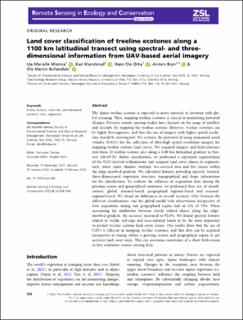| dc.contributor.author | Mienna, Ida Marielle | |
| dc.contributor.author | Klanderud, Kari | |
| dc.contributor.author | Ørka, Hans Ole | |
| dc.contributor.author | Bryn, Anders | |
| dc.contributor.author | Bollandsås, Ole Martin | |
| dc.date.accessioned | 2022-10-12T08:13:06Z | |
| dc.date.available | 2022-10-12T08:13:06Z | |
| dc.date.created | 2022-05-10T11:26:15Z | |
| dc.date.issued | 2022-03-04 | |
| dc.identifier.citation | Remote Sensing in Ecology and Conservation. 2022, 8 (4), 536-550. | en_US |
| dc.identifier.issn | 2056-3485 | |
| dc.identifier.uri | https://hdl.handle.net/11250/3025490 | |
| dc.description.abstract | The alpine treeline ecotone is expected to move upwards in elevation with global warming. Thus, mapping treeline ecotones is crucial in monitoring potential changes. Previous remote sensing studies have focused on the usage of satellites and aircrafts for mapping the treeline ecotone. However, treeline ecotones can be highly heterogenous, and thus the use of imagery with higher spatial resolution should be investigated. We evaluate the potential of using unmanned aerial vehicles (UAVs) for the collection of ultra-high spatial resolution imagery for mapping treeline ecotone land covers. We acquired imagery and field reference data from 32 treeline ecotone sites along a 1100 km latitudinal gradient in Norway (60–69°N). Before classification, we performed a superpixel segmentation of the UAV-derived orthomosaics and assigned land cover classes to segments: rock, water, snow, shadow, wetland, tree-covered area and five classes within the ridge-snowbed gradient. We calculated features providing spectral, textural, three-dimensional vegetation structure, topographical and shape information for the classification. To evaluate the influence of acquisition time during the growing season and geographical variations, we performed four sets of classifications: global, seasonal-based, geographical regional-based and seasonal-regional-based. We found no differences in overall accuracy (OA) between the different classifications, and the global model with observations irrespective of data acquisition timing and geographical region had an OA of 73%. When accounting for similarities between closely related classes along the ridge-snowbed gradient, the accuracy increased to 92.6%. We found spectral features related to visible, red-edge and near-infrared bands to be the most important to predict treeline ecotone land cover classes. Our results show that the use of UAVs is efficient in mapping treeline ecotones, and that data can be acquired irrespective of timing within a growing season and geographical region to get accurate land cover maps. This can overcome constraints of a short field-season or low-resolution remote sensing data. | en_US |
| dc.language.iso | eng | en_US |
| dc.publisher | John Wiley & Sons Ltd on behalf of Zoological Society of London | en_US |
| dc.rights | Navngivelse-Ikkekommersiell 4.0 Internasjonal | * |
| dc.rights.uri | http://creativecommons.org/licenses/by-nc/4.0/deed.no | * |
| dc.title | Land cover classification of treeline ecotones along a 1100 km latitudinal transect using spectral- and three-dimensional information from UAV-based aerial imagery | en_US |
| dc.title.alternative | Land cover classification of treeline ecotones along a 1100 km latitudinal transect using spectral- and three-dimensional information from UAV-based aerial imagery | en_US |
| dc.type | Peer reviewed | en_US |
| dc.type | Journal article | en_US |
| dc.description.version | publishedVersion | en_US |
| dc.rights.holder | © 2022 The Authors | en_US |
| dc.source.pagenumber | 536-550 | en_US |
| dc.source.volume | 8 | en_US |
| dc.source.journal | Remote Sensing in Ecology and Conservation | en_US |
| dc.source.issue | 4 | en_US |
| dc.identifier.doi | 10.1002/rse2.260 | |
| dc.identifier.cristin | 2023015 | |
| dc.relation.project | Norges forskningsråd: 281066 | en_US |
| cristin.ispublished | true | |
| cristin.fulltext | original | |
| cristin.qualitycode | 1 | |

